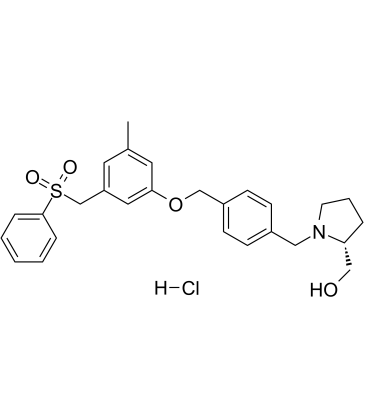1706522-79-3
| Name | PF-543 hydrochloride |
|---|---|
| Synonyms | MFCD28411614 |
| Description | PF-543 hydrochloride (Sphingosine Kinase 1 Inhibitor II hydrochloride) is a potent, selective, reversible and sphingosine-competitive SPHK1 inhibitor with an IC50 of 2 nM and a Ki of 3.6 nM. PF-543 hydrochloride is >100-fold selectivity for SPHK1 over SPHK2. PF-543 hydrochloride is an effective potent inhibitor of sphingosine 1-phosphate (S1P) formation in whole blood with an IC50 of 26.7 nM. PF-543 hydrochloride induces apoptosis, necrosis, and autophagy[1][2][3]. |
|---|---|
| Related Catalog | |
| Target |
IC50: 2 nM (SPHK1); 26.7 nM (Sphingosine 1-phosphate (S1P))[1] Ki: 3.6 nM (SPHK1)[1] |
| In Vitro | PF-543 (10-1000 nM; 24 hours; PASM cells) treatment abolishes SK1 expression at nM concentrations[2]. PF-543 (0.1-10 μM; 24 hours; PASM cells) treatment induces caspase-3/7 activity[2]. PF-543 inhibits C17-S1P formation in 1483 cells with an IC50 of 1.0 nM[1]. SphK1 inhibition by PF-543 causes a dose-dependent depletion of the intracellular level of S1P with EC50 concentration of 8.4 nM and a concomitant elevation of the intracellular level of sphingosine in 1483 cells. The level of endogenous S1P in 1483 cells after a 1 h treatment with 200 nM PF-543 is decreased 10-fold, producing a proportional increase in the level of sphingosine[1]. Western Blot Analysis[2] Cell Line: Human pulmonary arterial smooth muscle (PASM) cells Concentration: 10 nM, 100 nM, 1000 nM Incubation Time: 24 hours Result: Abolished SK1 expression at nM concentrations. Apoptosis Analysis[2] Cell Line: Human pulmonary arterial smooth muscle (PASM) cells Concentration: 0.1 μM, 1 μM, 10 μM Incubation Time: 24 hours Result: Induced caspase-3/7 activity in cultured human pulmonary smooth muscle cells. |
| In Vivo | PF-543 (1 mg/kg; intraperitoneal injection; every second day; for 21 days; female C57BL/6 J mice) treatment has no effect on vascular remodelling but reduces right ventricular hypertrophy. The protection involves a reduction in the expression of p53 and an increase in the expression of anti-oxidant nuclear factor Nrf-2[2]. Mice are initially dosed (ip) with 10 mg/kg or 30 mg/kg of PF-543 for 24 h and the T1/2 is 1.2 h in blood samples. Administration of 10 mg/kg PF-543 for 24 h to mice induces a decrease in SK1 expression in pulmonary vessels[2]. Animal Model: Female C57BL/6 J mice (7-12 week-old) with hypoxic-induced pulmonary arterial hypertension[2] Dosage: 1 mg/kg Administration: Intraperitoneal injection; every second day; for 21 days Result: Reduced right ventricular hypertrophy. The protection involves a reduction in the expression of p53 (that promotes cardiomyocyte death) and an increase in the expression of anti-oxidant nuclear factor Nrf-2. |
| References |
| Molecular Formula | C27H32ClNO4S |
|---|---|
| Molecular Weight | 502.07 |
| Hazard Codes | Xi |
|---|
